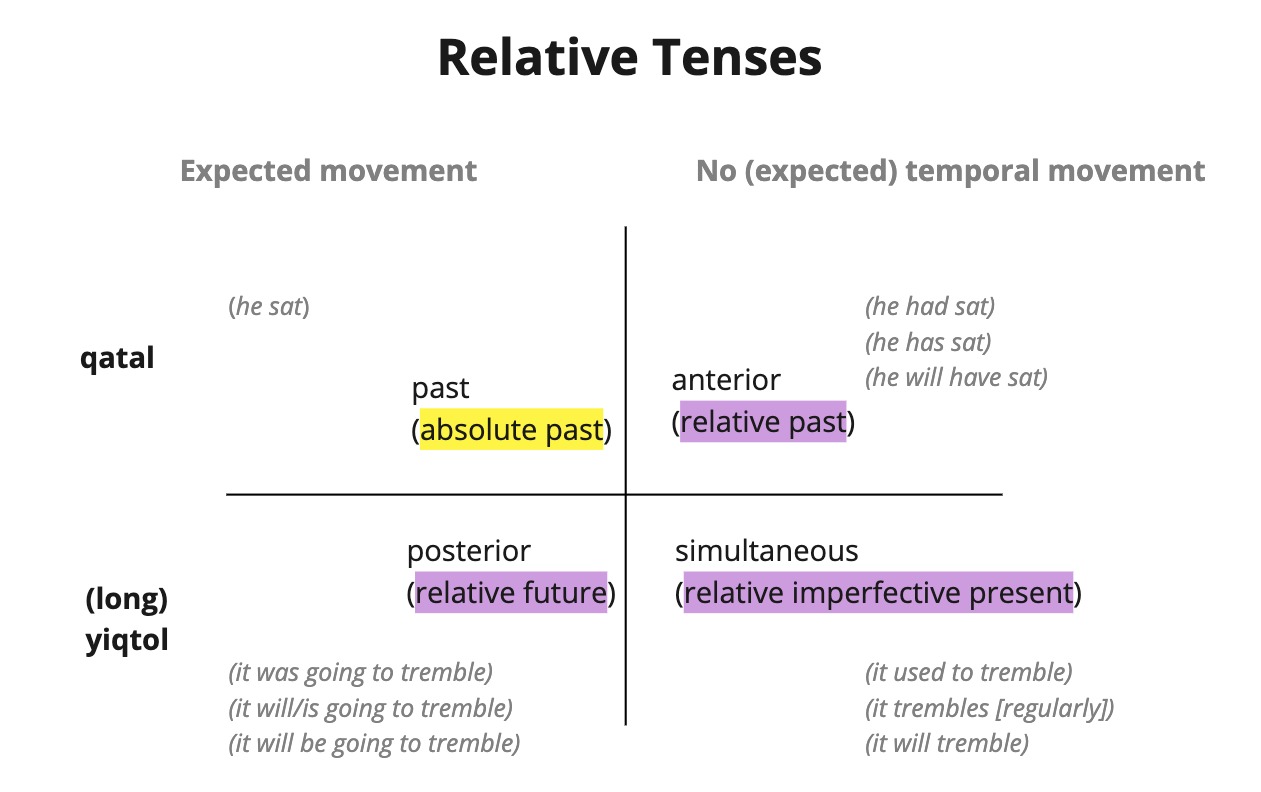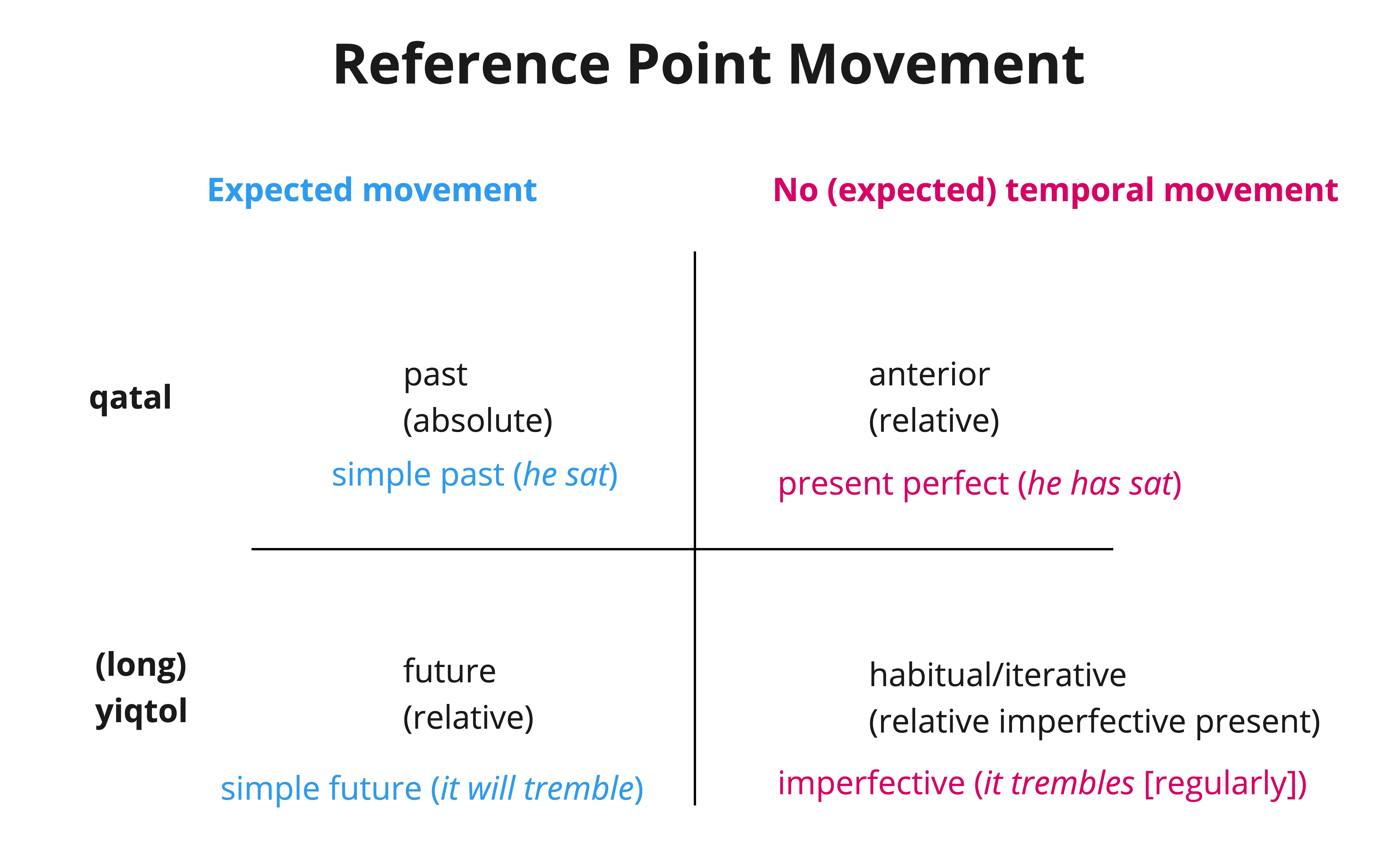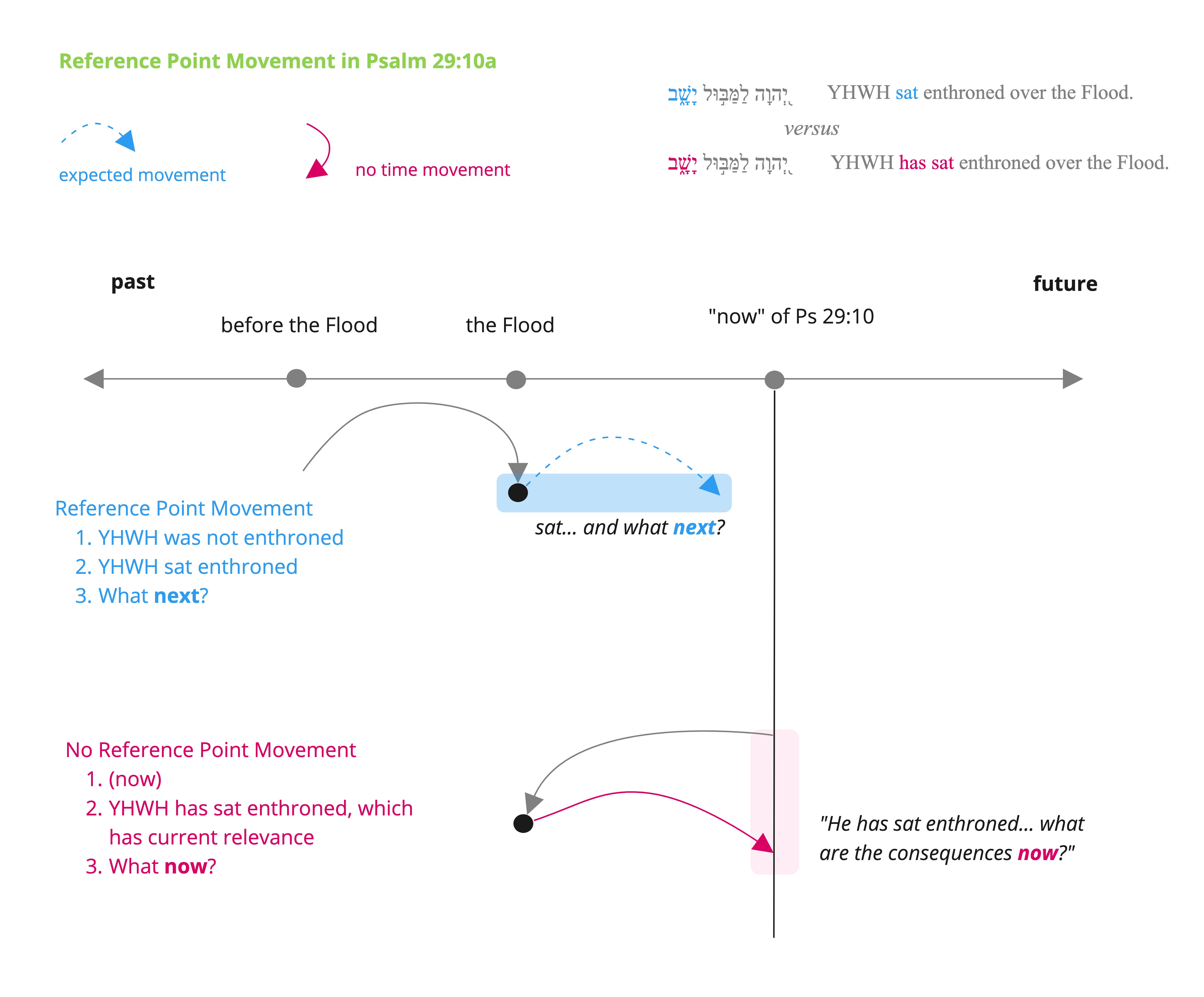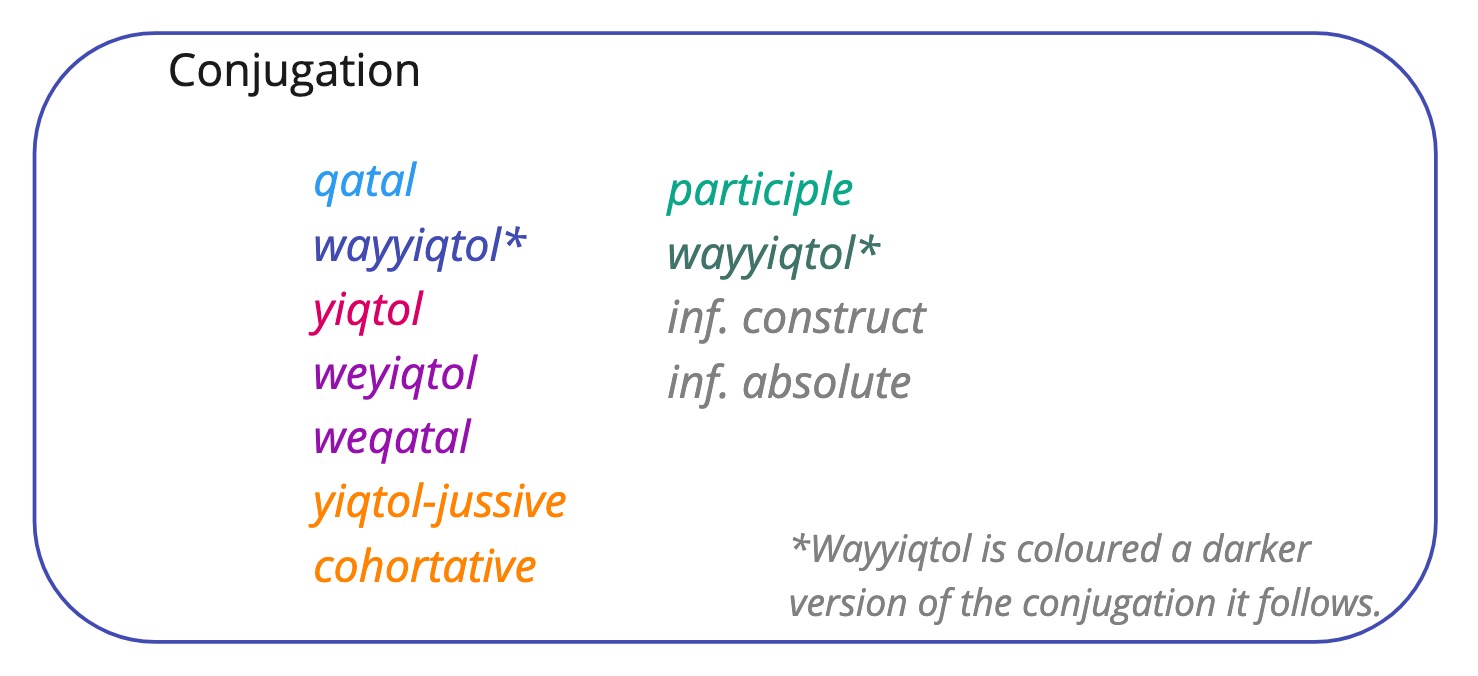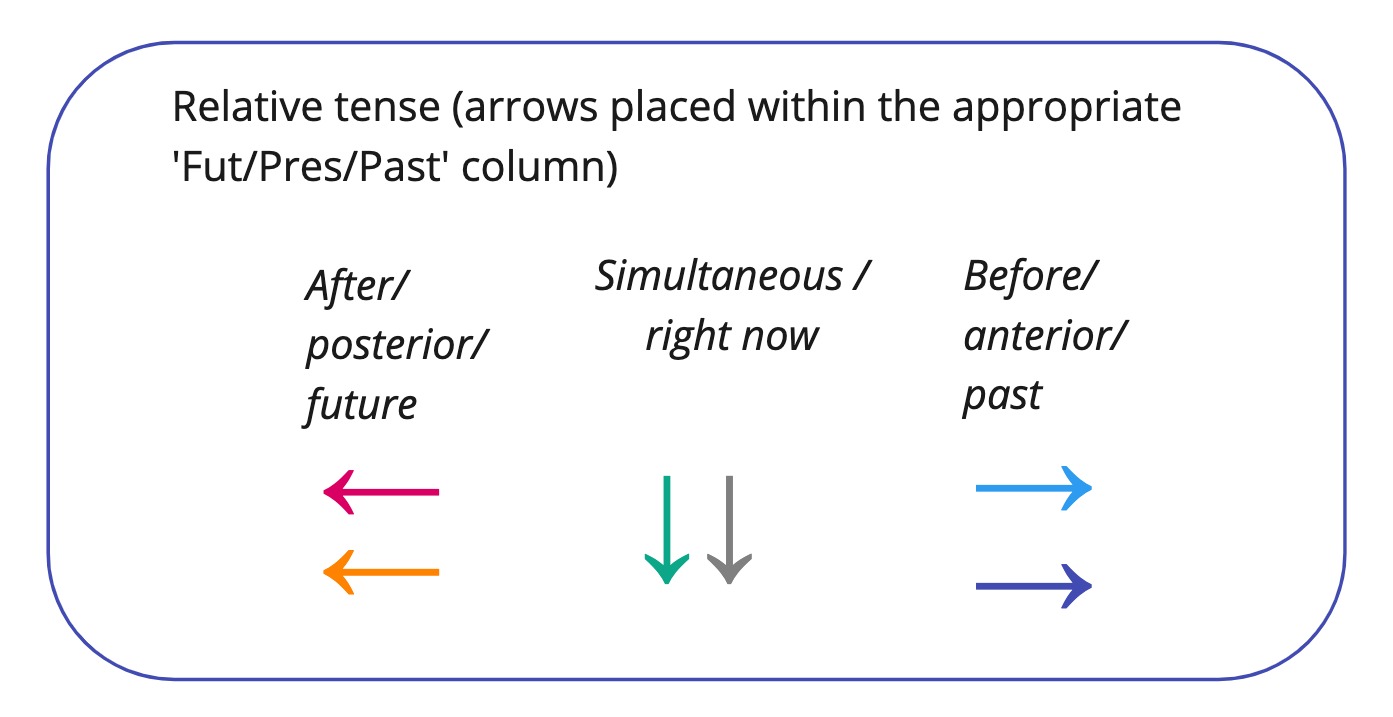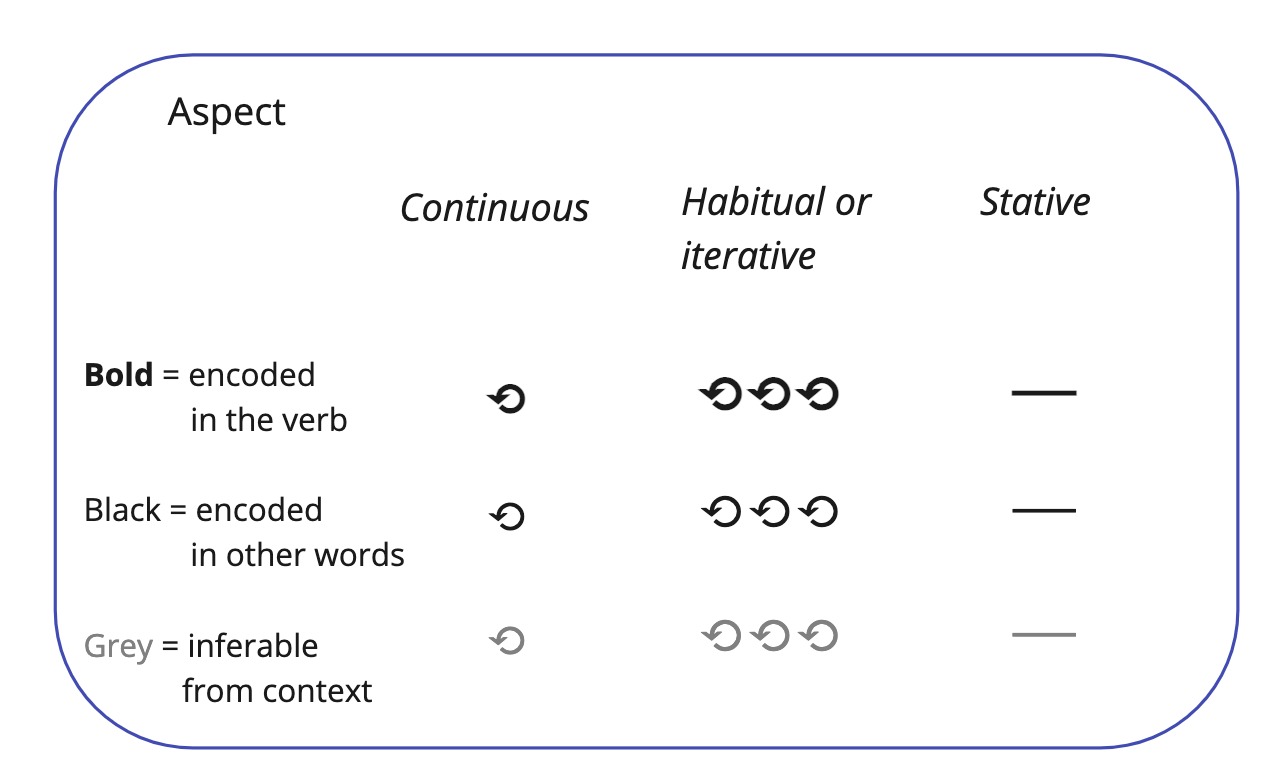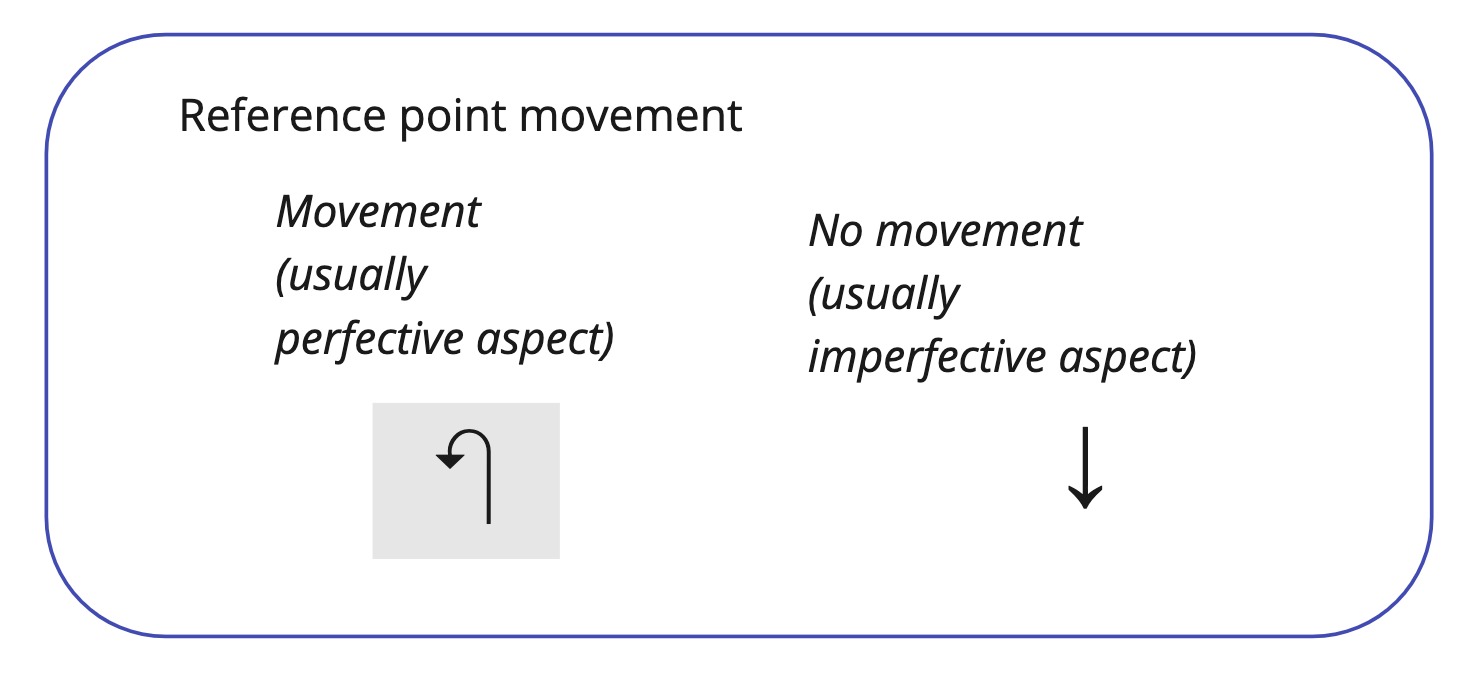Verbal Semantics
- Grammar
- Semantics
- Exegetical Issues
- Discourse
- Poetics
- Synthesis
- Close-but-Clear
- Videos
- Post to wiki
A fuller discussion may be found here.
Key Concepts
Layer Overseer: Elizabeth
This visualisation focuses on the relationship between verbs, time and modality. These are important categories for interpretation and translation, and how one analyses a verb can have a significant effect on how it is rendered. For example, notice how differently this selection of English versions translates the same verbs in Ps 3:8:
- הִכִּ֣יתָ אֶת־כָּל־אֹיְבַ֣י לֶ֑חִי // שִׁנֵּ֖י רְשָׁעִ֣ים שִׁבַּֽרְתָּ׃
- You strike . . . You shatter . . . (ESV, GNT)
- You have struck . . . You have shattered . . . (KJV, NASB)
- Strike . . . ! Shatter . . . ! (NIV, NLT, CEB)
- You will strike . . . You will shatter . . . (NET)
This layer has been through several iterations, as it strives to accomplish two things:
- Transparency for the native Hebrew structures
- Transparency for the interpretation necessary to translate the verbal semantics into other languages
Tense
- Relative tense: a situation’s location in time relative to a given reference point (anterior, simultaneous, or posterior)
- Absolute tense: a situation’s location in time relative to the moment of speech (past, present, future, timeless/unmarked)
'Tense' refers to the situation’s location in time: past, present, future, or timeless. These terms are actually a simplification, which is possible when the reference point is the time of speech:
- past = prior to speech time (anterior)
- present = simultaneous with speech time
- future = after speech time (posterior)
When a different reference point is used, it is more accurate to simply speak of time anterior, simultaneous, or posterior (if marked at all for location in time). When speech time is always assumed as the reference point, it is called absolute tense. When the reference point depends on context, it is called relative tense.
Hebrew has a combination of absolute tense and relative tense. Precisely because the tenses can be relative, it is vital to know what the reference point is -- what reference point the relative tense is relative to. (This is the reason for including reference point movement, below.)
| Relative tense of event | Reference point | English label | Example |
|---|---|---|---|
| Anterior | Past | Pluperfect (past-in-the-past) | He had built the temple. |
| Anterior | Present | Present perfect (past-in-the-present) | He has built the temple. |
| Anterior | Future | Future perfect (past-in-the-future) | He will have built the temple. |
| Simultaneous (English) but Posterior (Hebrew) | Past | Past habitual (present-in-the-past) | He would build temples. |
| Simultaneous (English) but Posterior (Hebrew) | Present | Present habitual (present-in-the-present) | He builds temples. |
| Simultaneous (English) but Posterior (Hebrew) | Future | Future habitual (present-in-the-future) | He will build temples. |
| Posterior | Past | (future-in-the-past) | He was going to build a temple. |
| Posterior | Present | (future-in-the-present) | He will/is going to build a temple. |
| Posterior | Future | (future-in-the-future) | He will be going to build a temple. |
N.B.: This may be misleading, if one is thinking of the action itself. Simultaneity in terms of ongoing action is represented in Hebrew by the participle, not yiqtol or qatal. Yiqtol can present English simultaneity in terms of relevance of a future action, just as qatal can present English simultaneity in terms of relevance of a past action.
Aspect
- Aspect: the 'temporal constituency' of a situation as portrayed (e.g. stative, continuous, or repeating)
Tense and aspect are conventional analytical categories, with situation aspect increasingly well established (particularly in its more limited form, lexical aspect). A former iteration of our verbal semantics tracked situation aspect for each verb, but it was not clear that the effort required had sufficient exegetical payoff. This version of verbal semantics does not track situation aspect. Instead, it tracks a more generic aspect that mostly coincides with viewpoint aspect in its more specific imperfective manifestations (continuous vs characteristic vs stative).
Aspect is determined from a combination of situation aspect and verbal conjugation. In Ps 29:5a, the plural 'cedars' suggests that the participial phrase YHWH's voice is breaking cedars is repetitive. In Ps 29:9c, it is unclear if everyone is saying 'Honour! Honour! Honour!' repeatedly (in which case it would also be repetitive aspect) or if there is a drawn-out ceremony that, altogether, declares the honour of God. In that case, it would be continuous aspect.
Aspect requires more development, so in part this is a placeholder. This may also be used for phrasal aspect, such as ingressive aspect (inceptive for actions, inchoative for states) or completive aspect (e.g. 'eat up' rather than just 'eat').
Reference point movement
- Reference point movement: whether or not the expected reference point in this discourse is updated after a situation, stereotypically tracking with perfective (movement) vs imperfective (no movement)
The category of reference point movement is exploratory. It holds the potential to explain the difference in English translation of Hebrew verbs, as a category that Hebrew does not distinguish but English does. The below diagram illustrates how reference point movement distinguishes between an English simple past and present perfect, as well as between an English future or imperfective present. Hebrew distinguishes neither of these pairs.
The nature of an ongoing text is that there is always a reference point for the next expected situation. With each new situation, the reference point may or not be updated. It is the expectation of reference point movement that matters here. The default for a narrative backbone is that the reference point advances with each action, leading the reader to expect What comes next? The default for a descriptive or non-narrative text is that the reference point does not advance, because not chronology but some kind of logic drives the text. The reader expects, then, What are the consequences now? of the most recent situation described. These two options are demonstrated below for Psalm 29:10. The essential point is that this category explains the need to distinguish between forms in English where no such distinction is needed in Hebrew.
- Modality: the effective modality as would need to be translated into English (e.g. imperative, jussive, subjunctive, conditional, wish)
Imperatives, jussives and cohortatives are volitional modals, by morphology[1]. We-qatal and we-yiqtol are often also purpose/result modals. Clause-initial yiqtol, if in an a-line, should be presumed purpose/result modal unless proven otherwise.
Other forms of modality, such as wish, possibility, permission, conditionals and some purpose are often indicated by discourse markers, such as לו, אולי, פן, בעבר, etc. This kind of modality will be expressed morphologically in English and many other languages, and therefore we will track it, noting how it is marked in Hebrew by means other than morphology.
The main categories of modality are deontic (permission, necessity and obligation) and epistemic (possibility or probability). Many languages express multiple forms of modality with the same wording, e.g. you may go can either be permission or possibility; you will go may be indicative future or probability.
Here is an outline, largely taken from the SIL Glossary, but including alethic modality (necessity and possibility) under epistemic modality.
- Deontic modality (obligation)
- Commissive: speaker's expressed commitment, as a promise or threat, to bring about the proposition expressed by the utterance
- Volitive: speaker’s attitude of hope, wish, or fear concerning the proposition expressed by the utterance.
- Optative (wishing or hoping)
- Imprecative (wish that an unfavourable position will come about)
- Directive (speaker’s degree of requirement of conformity to the proposition expressed by an utterance.)
- Deliberative: speaker's request for instruction from the addressee as to whether to do the proposition expressed in the utterance.
- Imperative: commands, sometimes extended to signal permission
- Cohortative/Jussive: speaker's command, permission, or agreement that the proposition expressed by his or her utterance be brought about.
- Obligative: speaker's estimation of the necessity that the proposition expressed in his or her utterance be brought about
- Permissive: speaker’s act of giving permission
- Precative: signals that the utterance is a request
- Prohibitive: signals a prohibition; distinguished by the use of negated imperatives with non-declarative negator or a verb form different from that of the imperative
- Epistemic modality: how much certainty or evidence a speaker has for the proposition expressed by his or her utterance
- Logical necessity (purpose/result)
- Possibility
- Evidentiality: conveys the source of knowledge for his or her statement
- Quotative: signals that someone else is the source of the statement made
- Sensory: speaker’s evidence for the truth of his or her statement is derived from the speaker’s own sensory experience
- Judgment Modality: connotes the speaker's strength of inference or degree of confidence
- Assumptive: speaker's belief that his statement is based on facts about what is usually the case in such circumstances
- Declarative: proposition expressed by a speaker’s utterance is offered as an unqualified statement of fact (can equate to indicative)
- Deductive: the speaker judges from other facts that the proposition expressed by his utterance is probably true.
- Dubitative: signals a speaker’s reservation about the accuracy of his or her statement
- Hypothetical: the speaker evaluates a proposition as counterfactual, but otherwise possible
- Interrogative: the speaker wishes to elicit information concerning the content of his or her utterance from the addressee
- Speculative: the speaker judges from certain facts that the proposition expressed by his or her utterance is possibly true
Steps
Before you begin...
- Copy the verbal semantics template and paste it onto your MIRO board.
- Copy the verbal semantics legend and paste it onto your MIRO board.
- Copy and paste the English and Hebrew texts in the relevant text boxes.
Overview:
- Split the Hebrew text into lines according to verbal instances. Colour the Hebrew verbs (in the second column) according to morphology.
- Identify the verb's root, stem, conjugation, person/gender/number, and any suffix.
- Identify the verb's relative tense (e.g. yiqtol=posterior, qatal=anterior) and absolute tense (nearly always present) and place the appropriate arrow for the relative tense into the appropriate Fut/Pres/Past column.
- Identify any nuance of modality (specifically continuous, iterative/habitual or stative).
- Determine the expected movement of the reference point for each clause.
- Specify the effective modality of every finite verb. Specify the reason for the chosen modality.
- Make the verbal gloss in the Close-but-Clear bold and coloured according to effective verbal semantics (so waw-conjoined forms will merge with their governing verbs and ambiguous yiqtols will be coloured for either any semantics they effectively have).
(For more information, click "Verbal Legend" below.)
1. Lay out the Hebrew text
Copy the table from the verbal semantics template and lay out the Hebrew text in the second column (one row per verb, whether finite, infinitive or participial; also one row per nominal clause). Use OSHB for the Hebrew text. You should also be able to find it on the forum.
Note: our goal is to not only analyse the finite verbs, but also those expressions that will be translated with verbs in other languages. This includes infinitives, predicative participles and verbless clauses. Adjectival participles do not need to be included.
2. Morphology
Identify in the table the root, stem, conjugation, person/gender/number and suffix of every verb. If there are multiple options, duplicate the row and colour the background of the non-preferred row grey. When you have settled the alternative (viable) option, then merge all cells that have identical data to draw attention to those areas where the interpretation is different.
These should be relatively uncontested entries.
Following the template, colour the text of the Hebrew of each verb according to its morphological conjugation (e.g. qatal light blue, wayyiqtol dark blue when following qatal).
3. Time
Tense
Identify both the relative tense (anterior, simultaneous or posterior, if tensed at all) and the absolute tense (future, present or past, if tensed at all). In the absolute tense column (usually 'Pres.'), put the arrow appropriate to the relative tense. Colour the arrow according to the conjugation.
| Posterior | ← |
|---|---|
| Simultaneous | ↓ |
| Anterior | → |
If tense is not applicable to the verbal form (as with many participles and nominal clauses), leave the columns blank.
Note that, the relative tense follows automatically from the conjugation (understanding that wayyiqtol, for instance, derives its values from a preceding verb, so the dark blue will repeat a preceding arrow).
Aspect
The Aspect column is for tracking nuances of aspect. We begin with tracking continuous (ongoing action at the time of the reference point), habitual or iterative (starting and stopping and resuming regularly) or stative (no change) aspect. We may track more aspects as we find them exegetically significant.
Note that the qatal of stative verbs usually conveys present tense state. They may sometimes be glossed felicitously as, e.g. זָקַנְתָּ, you have become old but sometimes only the present makes sense, e.g. יָפְיָפִיתָ, you are extremely beautiful.
Place the appropriate character in the Aspect column. Note that these are not images but actual characters. (Images make working with MIRO tables difficult. Everything in this table will be an actual character.)
| Continuous | ⟲ |
|---|---|
| Habitual or iterative | ⟲⟲⟲ |
| Stative | ⎯ |
Expected movement of the reference point
Indicated the expected movement of the discourse (advance movement for narrative sections, no movement for descriptive or logical sections) with the appropriate arrow. Set the background colour of cells with movement to grey (#808080) with 20% opacity. This will highlight stretches of possible narrative portions.
| Expected movement | ↶ |
|---|---|
| No expected movement | ↓ |
When you have finished, merge contiguous cells so you can see how reference point movement spans a stretch of discourse.
4. Modality
Modality is much less developed in Hebrew than in English. This column will make use of distinctions made in English, as the effective modality of the verb.
In the first modality column, specify the effective modality, coloured according to the template. If you have another kind of modality to specify, include it tentatively and, if a Live Review confirms it, it will be added to the template.
In the second column, specify the reason for your effective modality. Strive to select options from SIL's linguistic glossary.
Potential reasons include:
- morphology
- word order (clause-initial yiqtol is often modal)
- modal particles (e.g. פֶן, אִם)
- a preceding modal verb (we-yiqtol after imperative is usually purpose)
- location within a conditional
- intertextual echo (e.g. echoing the Aaronic blessing)
6. Close-but-clear
Using the Close-but-clear (or the developing version), bold and colour the translation of the verb according to the conjugation and effective modality (effective modality trumping conjugation, where they differ).
UPDATE: Note that arrows are NO LONGER coloured according to modality, but rather exclusively according to conjugation.
7. Notes
Indicate anything relevant to the verbal semantics that is not obvious from the rest of the chart. For example, if you have an auxiliary verbal construction, like ישמחו וירננו, "let them shout joyfully", include a note to this effect, e.g. "Auxiliary verb construction >> acts as an adverb, 'joyfully'". Make sure this is reflected in the CBC.
Cases of a paired yiqtol and qatal (in either order), such as Psalm 26:4, may function to convey something generally true. Note such pairs (which may be translated well by a present habitual in some languages).
8. Prepare for Review
See "Roles and Procedures" document for more instructions.
9. Revise and send for final checks.
Examples
Psalm 24:2 (qatal and yiqtol in parallel)
כִּי־ה֭וּא עַל־יַמִּ֣ים יְסָדָ֑הּ
וְעַל־נְ֝הָר֗וֹת יְכוֹנְנֶֽהָ׃
| Morphology | Time | Modality | ||||||||||
| Root | Stem | Conj | PGN | Suffix | Fut | Pres | Past | Aspect | Movt | Modality | Reason | Close-but-clear |
|---|---|---|---|---|---|---|---|---|---|---|---|---|
| יסד | Qal | qatal | 3ms | 3fs | → | ↓ | indicative | because he has laid its foundations upon the seas | ||||
| כון | Polel | yiqtol | 3ms | 3fs | ← | ⟲ | indicative | and keeps it established upon the oceans | ||||
Psalm 26:4 (qatal and yiqtol in parallel)
לֹא־יָ֭שַׁבְתִּי עִם־מְתֵי־שָׁ֑וְא
וְעִ֥ם נַ֝עֲלָמִ֗ים לֹ֣א אָבֽוֹא׃
This passages is a good example of how the English translation, based on our perception of reference point movement, is not determined from the local verb or even clause itself. The expected reference point movement is a feature of the larger discourse which shows up, encoded, in English verbs. This means we cannot give a proper translation into English until we have determined this larger discourse feature. (Or, more practically, we give it a go and revise as needed.)
Either of the below analyses is fully viable as far as the Hebrew is concerned. The appropriate English, reflecting reference point movement, will have to be determined from the larger discourse.
Interpreting this with no expected reference point movement
| Morphology | Time | Modality | ||||||||||
| Root | Stem | Conj | PGN | Suffix | Fut | Pres | Past | Aspect | Movt | Modality | Reason | Close-but-clear |
|---|---|---|---|---|---|---|---|---|---|---|---|---|
| ישׁב | Qal | qatal | 1cs | → | ↓ | indicative | I have not sat with worthless folk | |||||
| בוא | Qal | yiqtol | 1cs | ← | ⟲ | indicative | and I do not (regularly) go with hypocrites | |||||
Interpreting this with expected reference point movement
| Morphology | Time | Modality | ||||||||||
| Root | Stem | Conj | PGN | Suffix | Fut | Pres | Past | Aspect | Movt | Modality | Reason | Close-but-clear |
|---|---|---|---|---|---|---|---|---|---|---|---|---|
| ישׁב | Qal | qatal | 1cs | → | ↶ | indicative | I did not sit with worthless folk (in the past) | |||||
| בוא | Qal | yiqtol | 1cs | ← | indicative | and I will not go with hypocrites (in the future) | ||||||
Psalm 24:3 (yiqtol with permissive modality)
מִֽי־יַעֲלֶ֥ה בְהַר־יְהוָ֑ה
וּמִי־יָ֝קוּם בִּמְק֥וֹם קָדְשֽׁוֹ׃
| Morphology | Time | Modality | ||||||||||
| Root | Stem | Conj | PGN | Suffix | Fut | Pres | Past | Aspect | Movt | Modality | Reason | Close-but-clear |
|---|---|---|---|---|---|---|---|---|---|---|---|---|
| עלה | Qal | yiqtol | 3ms | ← | ↓ | permission | interrogative pronoun + context | Who may go up on the mountain of YHWH? | ||||
| קום | Qal | yiqtol | 3ms | ← | permission | interrogative pronoun + context | And who may stand within his holy place? | |||||
Bibliography
Cook, John. “Actionality (Aktionsart): Pre-Modern Hebrew.” In Encyclopedia of Hebrew Language and Linguistics. Edited by Geoffrey Khan. Consulted online on 22 September 2021 <http://dx.doi.org/10.1163/2212-4241_ehll_EHLL_COM_00000203>.
Fleischman, Suzanne. Tense and Narrativity: From Medieval Performance to Modern Fiction. Austin: University of Texas Press, 2010. PDF here.
Gentry, Peter. “The System of the Finite Verb in Classical Biblical Hebrew.” Hebrew Studies 39 (1998): 7–39. Link here.
Hornkohl, Aaron. “Biblical Hebrew Tense–Aspect–Mood, Word Order and Pragmatics: Some Observations on Recent Approaches.” Open-access version here.
Hovav, Malka. “Lexicalized meaning and the internal temporal structure of events.” Pages 13–42 in S. Rothstein (ed.), Theoretical and Crosslinguistic Approaches to the Semantics of Aspect. Amsterdam: John Benjamins, 2008. Available as PDF here.
Kroeger, Paul. Analyzing Meaning: An Introduction to Semantics and Pragmatics. Textbooks in Language Sciences 5. Berlin: Language Science Press, 2018. Part VI, “Tense & aspect” (pp. 377–446). This title can be downloaded here.
Levin, Beth. “Lexical Semantics of Verbs” course handouts. UC Berkeley, 2009. Course Page here. See especially “Lecture 4: Aspectual Approaches to Lexical Semantic Representation” (link). Cf. also Levin’s paper “Verb Classes within and across Languages,” 2013. (link)
McIntyre, Andrew. “Tense, Aspect and Situation Type."
Nadathur, Prerna. “Lexical Semantics” course handouts. Institut für Sprache und Information Heinrich Heine Universität, 2019–20. Course page here. See especially “Week 11: Aspect and aspectual classes I” (link).
“Tense, Aspect, and Modality with Nora Boneh (Part 1 of the Verbal Systems of the Biblical Languages series). The Biblical Languages Podcast. Biblingo, 2021. Link here.
Vendler, Z. “Verbs and Time.” Pages 97–121, Chapter 4 of Linguistics in Philosophy. Ithaca, NY: Cornell University Press, 1967. Link here.
Glossary
For terms not included here, please see SIL’s “Glossary of Linguistic Terms.”
Accomplishment: a situation type in which the event happens over time (durative), but does have a natural endpoint (telic). Unlike semelfactives (e.g. blink), accomplishments involve a change, e.g. run a mile; build a house.
Achievement: a situation type in which the event does not happen over time (punctual), but does have a result state. Achievements occur at a single moment, e.g. reached the top; find; win.
Activity: a situation type in which the event happens over time (durative), but doesn’t have a natural endpoint (atelic).
Aspect: a grammatical category which refers broadly to the relationship between a situation and time; cf. situation type; viewpoint aspect.
Atelic: see telicity.
Durativity: This aspectual property asks if the situation starts and stops. A durative situation extends over time (includes states, resultant states, and continuous action). E.g., She was swimming. A punctual situation is presented as happening instantaneously (includes repetitive actions). E.g., He kicked the ball (single), or He was kicking the ball (repetitive).
Phasal aspect:
Punctual: see durativity.
Semelfactive: a situation type in which the event is punctual, but without any resultant state.
Situation type: sometimes referred to as Aktionsart or situation aspect. The most basic distinction is between state and event. A state is a situation characterised by durativity and lack of change, e.g. possessing, desiring, loving, ruling, believing. An event is a situation in which something “happens,” e.g. eating, listening, teaching. An event may be one of four different situation types, see accomplishment; achievement; activity; semelfactive.
Telicity: the property of a situation which indicates whether or not the situation has a natural end point; a situation is either telic or atelic.
Tense: refers to a situation’s location in time.
Viewpoint aspect: sometimes referred to simply as aspect. The traditional distinction in viewpoint aspect is between perfective and imperfective aspect. This category is concerned with how the situation is represented, not its inherent properties. See perfective; imperfective.
- ↑ The cohortative morphology becomes the standard 1cs morphology for wayyiqtol forms in Late Biblical Hebrew
